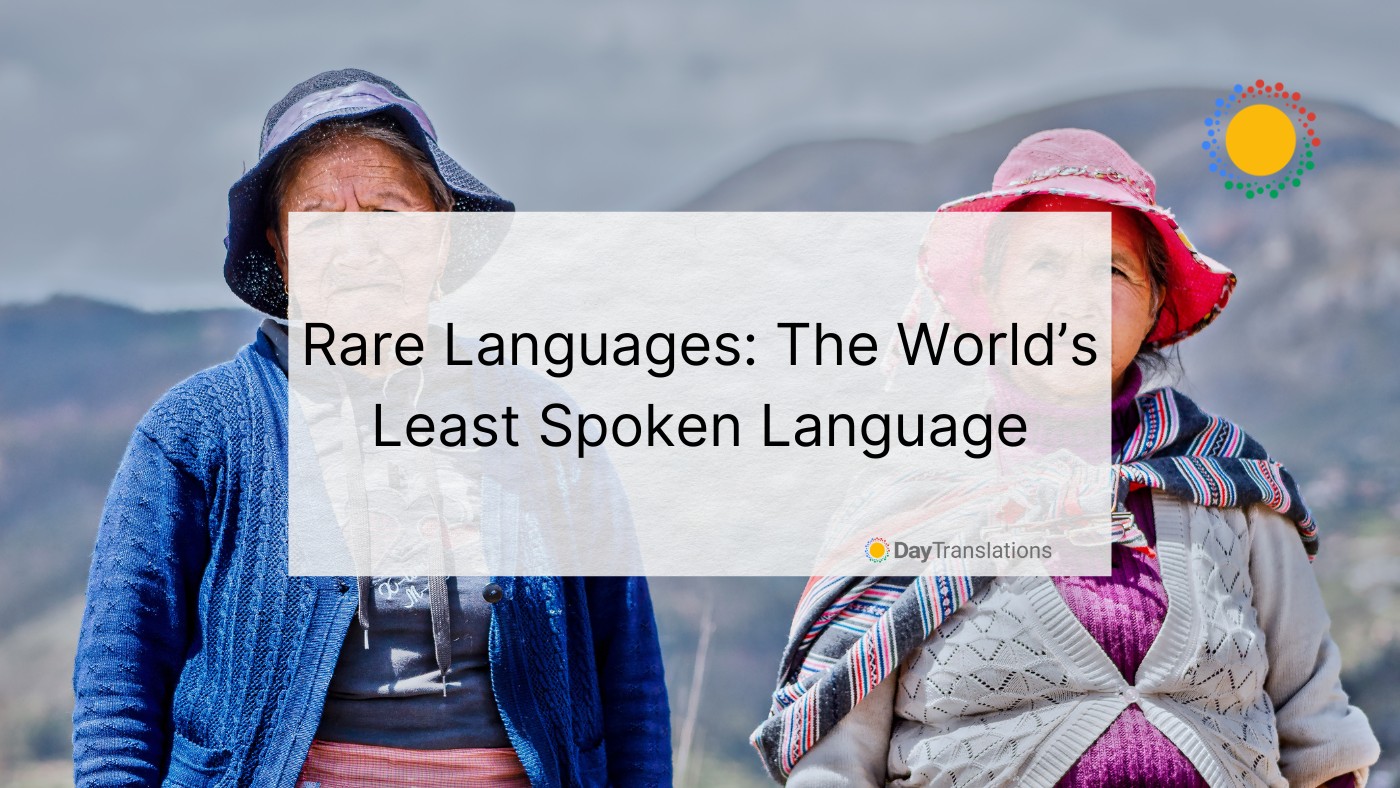Are you clued up on the world’s least spoken language? The latest statistical data from Ethnologue places the number of living languages in the world at 7,099. The number could be more since the remote areas in places such as Papua New Guinea and the Amazon are still too difficult to reach. Only a little over 200 languages are spoken in Europe, while more than 2,000 are spoken in Asia. It is surprising that a small country such as Papua New Guinea, with a population of over three million speaks about 832 languages.
Around the world, tribes in remote areas speak rare languages. The problem is the dwindling number of speakers. They still speak the language they learned as a child. However, many of them have children who have no interest in learning or speaking their language, preferring to speak the dominant language in their locality or country. The phenomenon causes languages to die or become extinct, unless there is concerted effort to revive the language.
Finding the World’s Least Spoken Language
According to the Atlas of World Languages of UNESCO, 64 languages among those that are critically endangered have only 1 to 2 speakers. Here’s a look at the roundup of qualifiers for the least spoken language in the world:
| 2 speakers | 1 speaker |
| Andoa (Peru) | Apiaká |
| Arikapu | Bikya |
| Aurê-Aurá | Bishuo |
| Baré (Brazil) | Chaná |
| Cayuvava | Dampel |
| Gajerrong | Diahói |
| Ganggalidda | Kaixána |
| Guarasu | Laua |
| Klallam | Patwin |
| Kujubim | Pazeh |
| Kunjen | Pémono |
| Kuruáya | Taushiro |
| Lemerig | Tinigua |
| Luri | Tolowa |
| Maidu | Volow |
| Oneida (New | Wintu-Nomlaered |
| Poyanawa | Yahgan |
| Puruborá | Yarawi |
| Salamãy | |
| Sambe | |
| Spokane | |
| Tharkarri | |
| Vacacocha | |
| Wangaaybuw | |
| Xipáya |
Although some providers of translation services are capable of translating rare languages today, there will come a time in the very near future when these rare languages are no longer available.
Here’s a look at some of the rare languages, where they are spoken and the number of speakers today.
Njerep
In Nigeria, there are still four individuals who speak Njerep. It is one of the Mambiloid languages, which is a branch of the larger Benue–Congo languages. The language is already extinct in Cameroon. It is critically endangered as the youngest person still speaking the language was born in the 1940s. Right now, it is used to keep the conversation secret. For casual conversation, people use Mambila languages like Mvop and Ba. According to anthropologists, it does not have a chance of survival.
Kawishana
Kawishana or Kaixana is native to Brazil. It is an Arawakan language that is spoken in places close to the Japura River. Once a very popular language, only one documented person who speaks the language remains. The UNESCO Atlas (2017) does not have it in its list of extinct languages while it is no longer included in the current list of living languages of Ethnologue (2017 edition).
Paakantyi
Varying reports about the actual number of active speakers of Paakantyi exist. Accordingly, about 2 to 24 speakers of one of the languages of the Aborigines of Australia remain. What cannot be denied is the fact that it is also critically endangered. Some schools in Australia are attempting to reintroduce the language to the younger generation.
Liki
Liki, which is also known as Moar, is spoken in the Papua region in Indonesia by people who live in the islands off the coast of Sarmi Kecamatan, Jayapura Kabupaten and Sarmi. It was once a very popular language, and was used by the indigenous church officials in the region. There are still about 11 remaining speakers of Liki, within the ethnic population of 320. Liki is related to the Sarmi-Jayapura Bay languages.
It is of mixed origin, as it is believed to have been developed from the Sarmi, Sarmi-Jayapura Bay, North New Guinea, Western Oceanic, Oceanic, Eastern Malayo-Polynesian, Central-Eastern, Malayo-Polynesian, and Austronesian languages.
Sarsi
Sarsi or Sarcee, which is spoken by the Tsuu T’ina tribe located in Calgary, Canada, is related to Navajo, the language spoken by the tribe in the southern part of the United States. It is an oral language with no evidence of a writing system. Written records about the language are not available either. In the 2011 census, about 170 still speak the language.
Chemehuevi
Chemehuevi belongs to the Uto-Aztecan language family and part of the Numic language branch. It is spoken in the U.S. Midwest, Colorado River in California, southern regions of Nevada, northern parts of Arizona, Utah, Southern Paiute, Ute and in Colorado although the speakers are not very fluent. Extensive recordings and field notes created by known linguist Margaret L. Press in the 1970s of fluent speakers of Chemehuevi are still available.
There were about 3 fluent speakers of the language remaining in 2008, when linguists K. David Harrison and Greg Anderson interviewed them for the filming of The Linguists, a 2008 documentary film produced by Ironbound Films. The language is being revived through a program of the Siwavaats Junior College located in California’s Havasu Lake. It already has a 2,500-word dictionary. In Chemehuevi, the ground or soil is tittvip¸ a tree is mahav, the ocean is hucip and the mountain is kaiv.
Chamicuro
Chamicuro, also known as Chamicura or Chamicolo, is a traditional language in Peru. There are only two known speakers of the language today. No children are able to speak the language because they prefer to use Spanish. But the previous speakers of the language developed a dictionary, so there is a written document for the language. Many of the words include names of animals such as cow (waka), cat (mishi), dog (ma’nali), monkey (katujkana), duck (pato), chicken (polyo) and horse (kawali).
Dumi
Dumi is a language spoken around the Rava and Tap rivers and in the Khotang District in Nepal. Its alternate names are Sotmali, Ro’do Bo’, Lsi Rai, Hopupo Bro, Dumi Bro and Dumi Bo’o. It belongs to the Kiranti branch of the Tibeto-Burman language family. Current data states that there are only 7 remaining speakers of the language. Written records are available, such as a dictionary and several books that show the grammar and syntax of the Dumi language. Dumi is the world’s least spoken language and one of the rarest.
Ongota
Also known as Shanqilla, Birelle, Birale and Ifa, Ongota is a language spoken in southwestern Ethiopia. The 2012 report of UNESCO said that there are only 12 individuals who speak the language. It may not disappear, as there is a professor from Addis Ababa University in Ethiopia who is studying the language. Ongota is an Afro-Asiatic language that could be heard spoken in a village at the west bank of the Weyt’o River.
Tanema
Tanema, which is also called Tetau, Tetawo or Tanima, is a language that used to be spoken in a village in Emua, in the province of Temotu and the island of Vanikolo, all found in the Solomon Islands. It is still considered a living language but is already nearly extinct as there is only one known speaker of Tanema, identified as Lainol Nalo, out of an ethnic population of 150 persons. Tanema is an Oceanic, Central Eastern and Malayo-Polynesian language that has been overtaken by Teanu and Pijin (Pisin), two languages that are increasingly becoming popular in the area. Some of the verbs include la munana that means, ”to lie down,” la vamora meaning, ”to work,” laro, which means, ”to swim” ad wekini, which means, ”to turn.”
Lemerig
Lemerig, which is also known as Lem, Leon, Sasar, Bek or Päk, is a language that used to be widely spoken in the northeastern coastal villages, in the Vanua Lava island and the Torba province of Vanuatu, which is located in the southern region of the Pacific Ocean. Its closest neighbor is Australia. Today only two fluent speakers remain, so it is on the brink of extinction. Lemerig is a mix of about four different dialects that are now extinct. Most people in the area today speak either Vera’a or Mwotlap or both.
Taushiro
Taushiro, which is also called Pinchi or Pinche is a language isolate that is spoken primarily in the Loreto region and around the Tigre River, and the Ahuaruna River tributary, the Aucayacu River in Peru. Former speakers of the language count only up to 10 while using their fingers. In Taushiro, the numeral 1 is washikanto. For numbers over 10, the native speakers would say ashintu and point to a specific toe to denote the particular number. It is nearing extinction as only one fluent speaker remains. Because it is a language isolate, it does not seem that it will be revived as the ethnic population only consists of 20 individuals.
Pawnee
Pawnee is a Native American Indian dialect found around Nebraska and north central Oklahoma. Although there are still 10 persons who are native speakers of Pawnee, all of them are elderly. Their children prefer to speak English as their mother tongue. Only the Elders and Chiefs of the Pawnee tribe speak the language fluently. The dialect has nine consonants and eight vowels. It’s remarkable that each Pawnee word has 10 syllables. The pronunciation of the consonants is similar to English. The vowels on the other hand are more similar to French in pronunciation, with long sounds. Speakers raise or lower the tone to impart different meanings.
Least Spoken Language – Critically Endangered Languages
Still around but with decreasing number of speakers are several more rare languages, such as:
- Friulian. Majority of the speakers are found near the Slovenian border with northern Italy
- Spoken by South America’s Tuyuca tribe located along the Tiquié, Inambú and Papurí rivers
- Spoken by the Yupik tribe in far eastern Russia and Alaska
- A language exclusively spoken in the Archib village and six other smaller villages in the southern part of Dagestan in Russia. The unique language has about 1.5 million derivatives for each verb root.
- Pirahã. A group of isolated people in Brazil speak Piraha. About 300 native speakers remain today. It is the only dialect left from the Mura language of the Amazonas.
According to the United Nations, every two weeks, we lose one language. About 6,000 languages might go extinct, due to the loss of native speakers, integration of other similar languages and because more people prefer to use the more dominant languages. Language affects all of us. Just imagine life without it.












Sorry, the comment form is closed at this time.